1988 PONTIAC FIERO ignition
[x] Cancel search: ignitionPage 726 of 1825
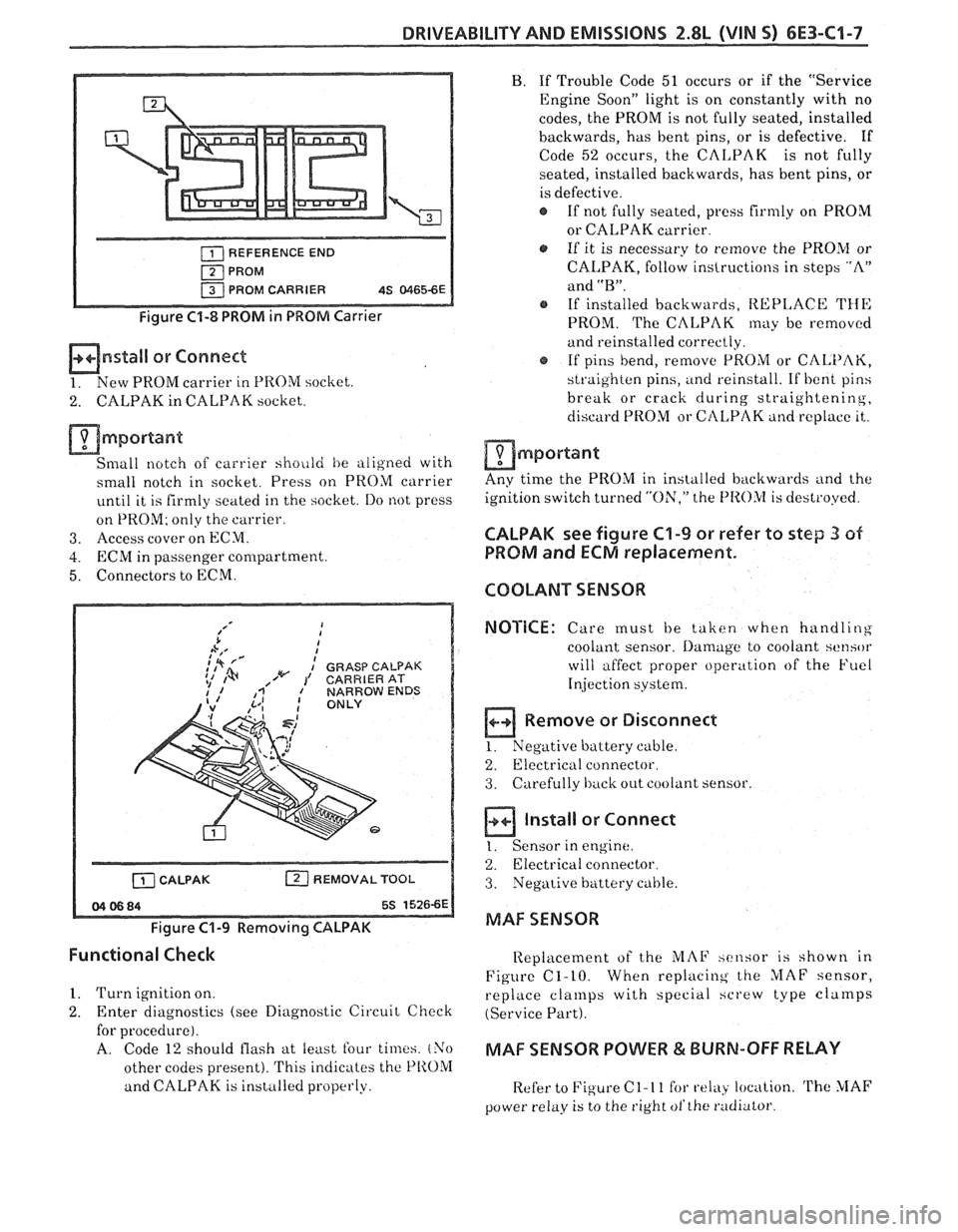
DRIVEABILITY AND EMISSIONS 2.8L (VIN S) 6E3-C1-7
REFERENCE END
PROM PROM CARRIER
4S 81165-6E
Figure C1-8 PROM in PROM Carrier
mnstall or Connect
1. New PROM carrier in PROM socliet.
2. CALPAK in CALPAK socket.
mmportant
Small notch of carrier shoiild he aligned with
small notch in socket. Press on PROM carrier
until it is firmly seated in the socket. Do not press
on PROM; only the carrier.
3. Access cover on ECM.
4. ECRil in passenger compartment.
5. Connectors to ECM.
b A,' I
;,* fd I
: GRASP CALPAK 1% ,/w 1' CARRIERAT
[ZJ REMOVAL TOOL
Figure C1-9 Removing CALPAK
B. If Trouble Code 51 occurs or if the "Service
Engine Soon" light is on constantly with no
codes, the PROM is not fully seated, installed
backwards, has bent pins, or is defective. If
Code
52 occurs, the CALPAK is not fully
seated, installed backwards, has bent pins, or
is defective.
If not fully seated,
press firmly on PROM
or CALPAK carrier
a, If it is necessary to remove the PROM or
CALPAK, follow instructions in steps "A"
and
"B".
@ If installed backwards, REPLACE THE
PROM. The CALPAK may be removed
and reinstalled correctly.
@ If pins bend, remove PROM or CALPAK,
straighten pins, and reinstall. If
bent pins
break or crack during
straightening,
discard PROM or CtILPAK and replace it,.
am port ant
Any time the PROM in installed backwards and the
ignition switch turned
"ON," the f'I
PROM and ECM replacement.
COOLANT SENSOR
NOTICE:
Care must be taken when handling
coolant sensor.
Damage to coolant sensor
will affect proper operation of the Fuel
Injection
system.
B Remove or Disconnect
1. Negative buttery cable.
2.
Electricril connector.
3. Carefully back out coolant sensor.
a ln,aIl
1. Sensor in
or Connect
engine.
2. Electrical connector.
3. Negative battery cable.
MAF SENSOR
Functional Check
Replacement of the iL'IAF xcnsor is shown in
Figure C1-10. When
replacing the MAF sensor,
1. Turn ignition on.
replace cla~llps with special hcrew type cla~rlps
2. Enter diagnostics (see Diagnostic Circuit Check (Service Part).
for procedure).
A. Code 12 should flash at least four times. (Yo MAF SENSOR POWER & BURN-OFF RELAY
other codes present). This indicates the PIIOM
and CALPAK is installed properly.
Refer to Figure C 1- 1 1 for relay location. 'rhe MAF
power relay is to the right ofthe radiator
Page 728 of 1825
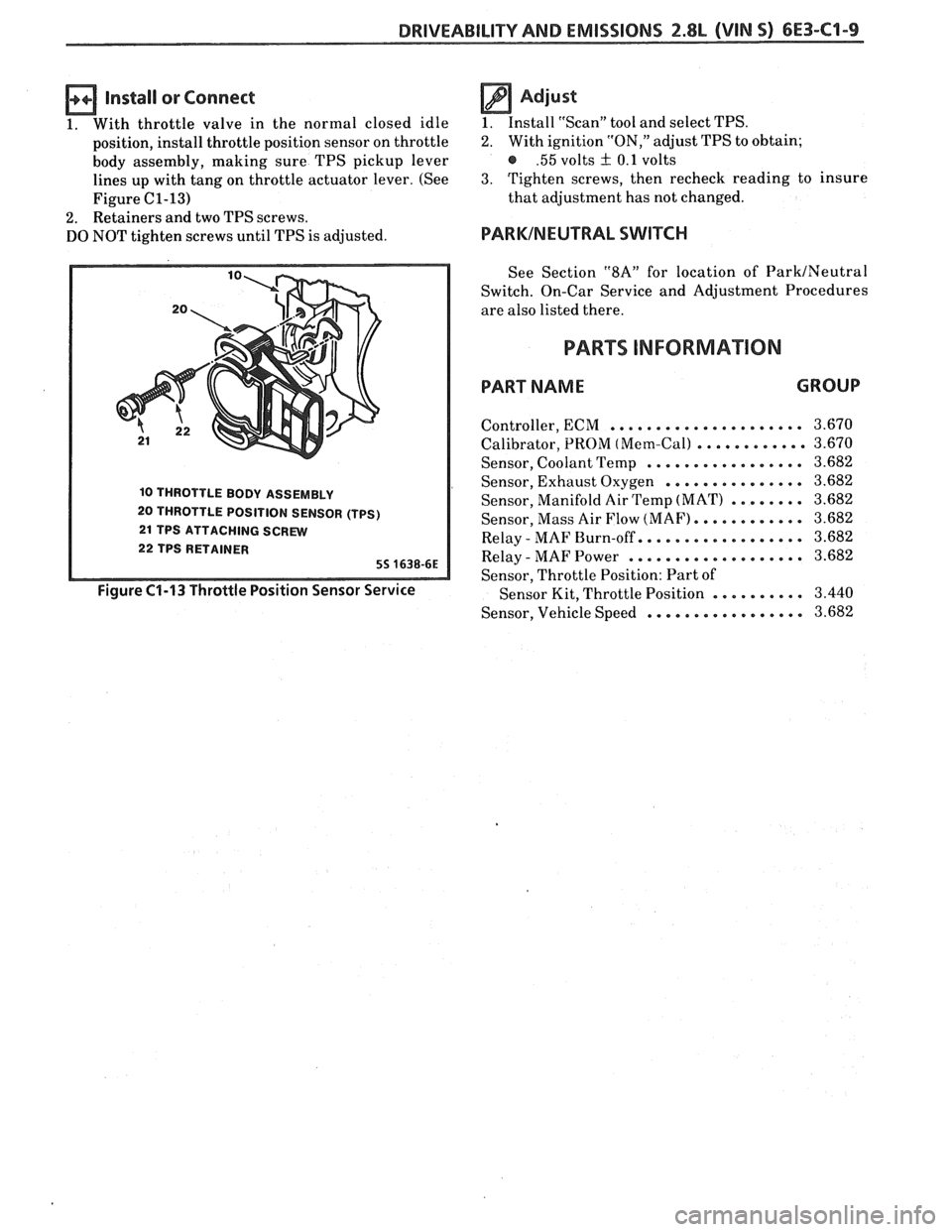
DRIVEABILITY AND EMISSIONS 2.8L (VIN 5) 6E3-C1-9
Install or Connect
1. With throttle valve in the normal closed idle
position, install throttle position sensor on throttle
body assembly, making sure TPS pickup lever
lines up with tang on throttle actuator lever. (See
Figure
C1-13)
2. Retainers and two TPS screws.
DO NOT tighten screws until TPS is adjusted.
10 THROTTLE BODY ASSEMBLY
20 THROTTLE POSITION SENSOR (TPS)
21 TPS ATTACHING SCREW
22 TPS RETAINER
55 1638-6E
Figure C1-13 Throttle Position Sensor Service
Adjust
1. Install "Scan" tool and select TPS.
2. With ignition "ON," adjust TPS to obtain;
@ .55 volts + 0.1 volts
3. Tighten screws, then recheck reading to insure
that adjustment has not changed.
PARKINEUTRAL SWITCH
See Section "$A" for location of ParkINeutral
Switch. On-Car Service and Adjustment Procedures
are also listed there.
PARTS INFORMAION
PART NAME GROUP
..................... Controller, ECM
Calibrator, PROM
(Mem-Call ............
Sensor, Coolant Temp .................
Sensor, Exhaust Oxygen ...............
Sensor, Manifold Air Temp (MAT) ........
Sensor, Mass Air Flow (MAF). ...........
Relay - MAF Burn-off.. ................
Relay - MAF Power ...................
Sensor, Throttle Position: Part of
Sensor Kit, Throttle Position
..........
Sensor, Vehicle Speed .................
Page 731 of 1825
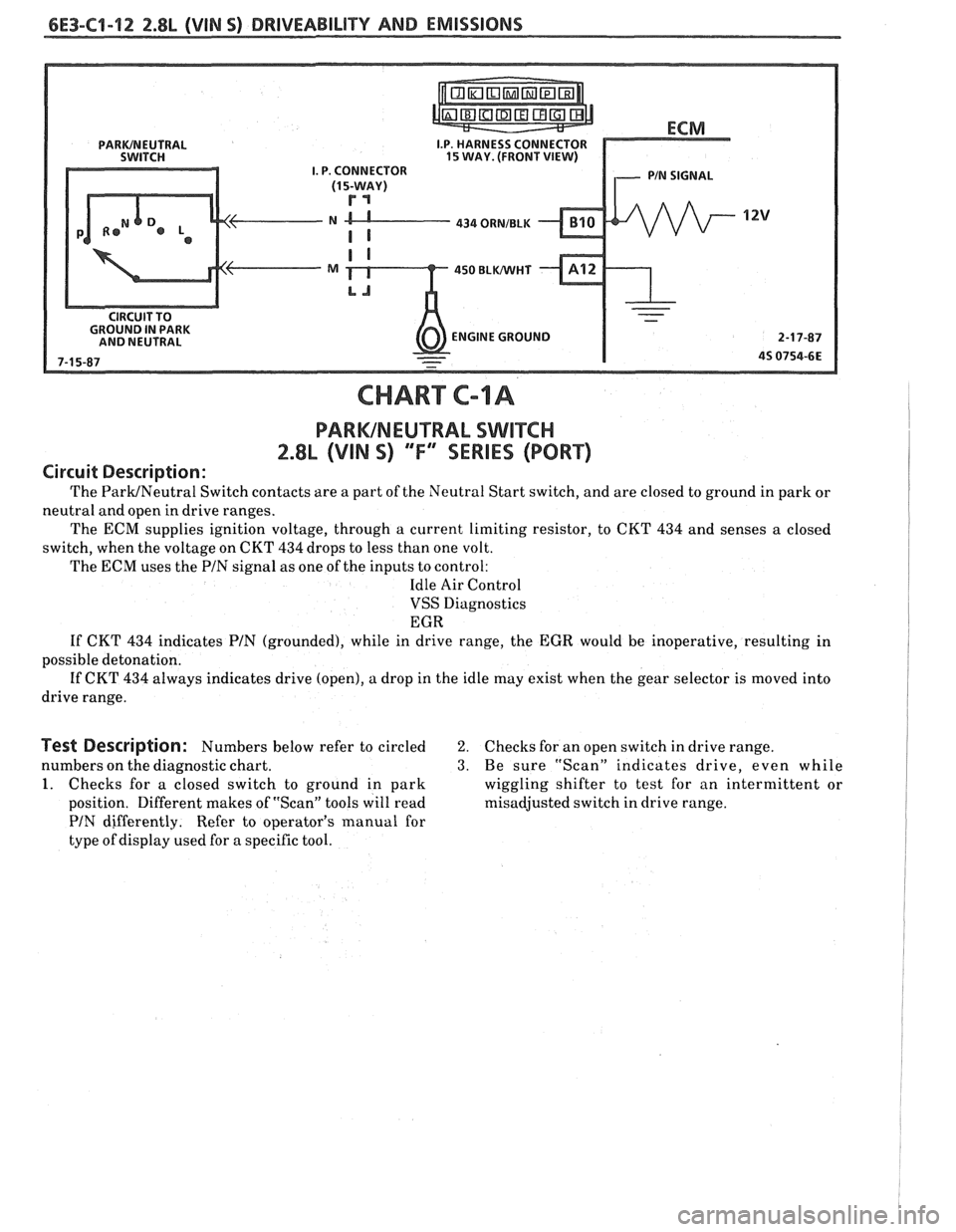
6E3-C1-12 2.8L (VIN 5) DRIVEABILITY AND EMISSIONS
15 WAY. (FRONT VIEW)
434 ORNIBLK
450 BLWHT
ENGINE GROUND
CHART C-IA
PARWNEUTRAL SWITCH
2.8L (VIN S) "F" SERIES (PORT)
Circuit Description:
The ParWNeutral Switch contacts are a part of the Neutral Start switch, and are closed to ground in park or
neutral and open in drive ranges.
The ECM supplies ignition voltage, through a current limiting resistor, to CKT
434 and senses a closed
switch, when the voltage on CKT
434 drops to less than one volt.
The
ECM uses the PIN signal as one of the inputs to control:
Idle Air Control
VSS Diagnostics
EGR
If CKT 434 indicates PIN (grounded), while in drive range, the EGR would be inoperative, resulting in
possible detonation.
If CKT 434 always indicates drive (open), a drop in the idle may exist when the gear selector is moved into
drive range.
Test Description: Numbers below refer to circled 2. Checks for an open switch in drive range.
numbers on the diagnostic chart.
3. Be sure "Scan" indicates drive, even while
1. Checks for a closed switch to ground in park wiggling shifter to test for an intermittent or
position. Different makes of "Scan" tools will read misadjusted switch in drive range.
PIN differently. Refer to operator's manual for
type of display used for a specific tool.
Page 737 of 1825
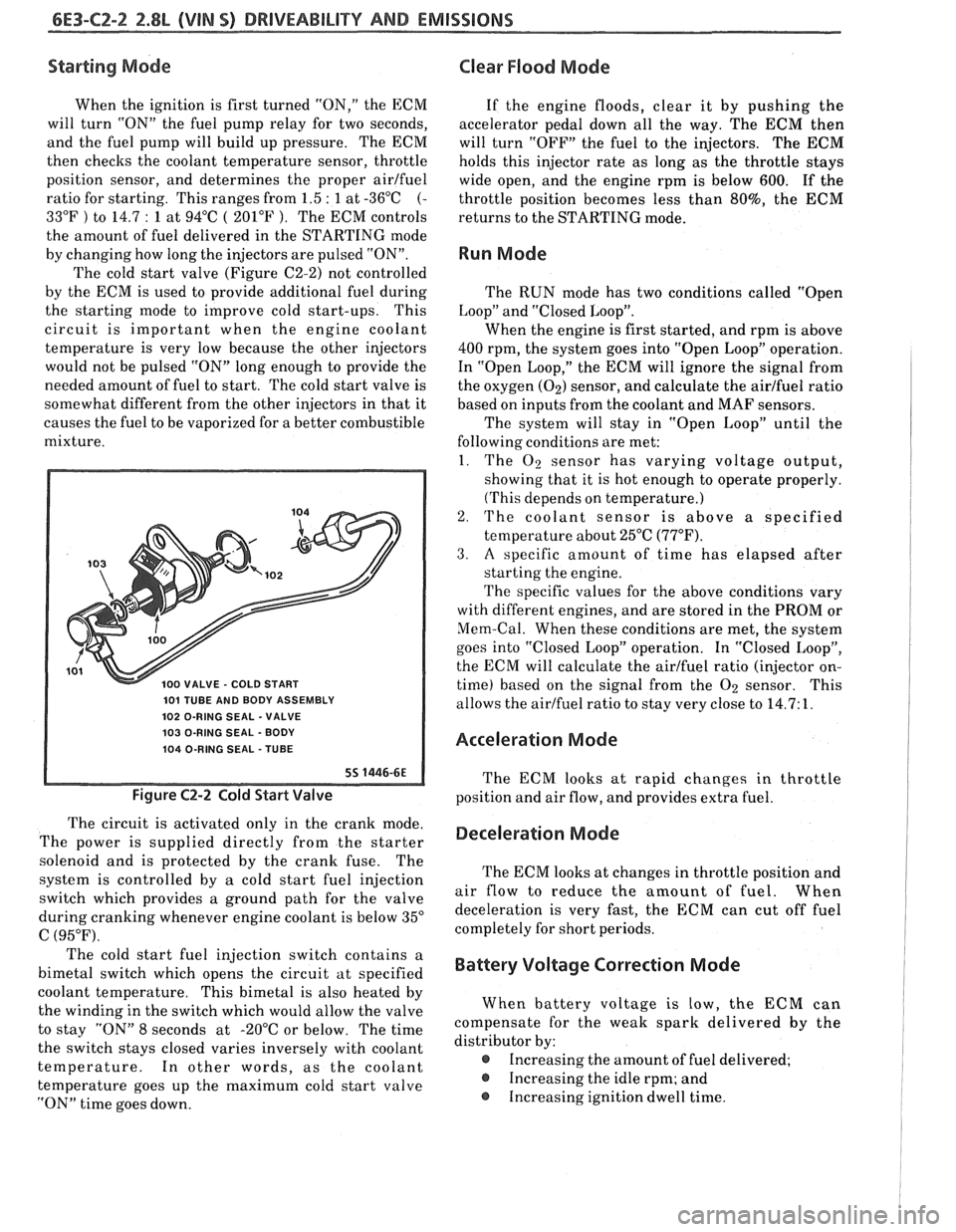
Starting Mode
When the ignition is first turned "ON," the ECM
will turn "ON" the fuel pump relay for two seconds,
and the fuel pump will build up pressure. The ECM
then checks the coolant temperature sensor, throttle
position sensor, and determines the proper airlfuel
ratio for starting. This ranges from 1.5
: 1 at -36°C (-
33°F ) to 14.7 : 1 at 94°C ( 201°F ). The ECM controls
the amount of fuel delivered in the STARTING mode
by changing how long the injectors are pulsed "ON".
The cold start valve (Figure C2-2) not controlled
by the ECM is used to provide additional fuel during
the starting mode to improve cold start-ups. This
circuit is important when the engine coolant
temperature is very low because the other injectors
would not be pulsed "ON" long enough to provide the
needed amount of fuel to start. The cold start valve is
somewhat different from the other injectors in that it
causes the fuel to be vaporized for a better combustible
mixture.
101 TUBE AND BODY ASSEMBLY
102 O-RING SEAL
- VALVE
103 O-RING SEAL
- BODY
104 O-RING SEAL
- TUBE
Figure C2-2 Cold Start Valve
The circuit is activated only in the crank mode.
The power is supplied directly from the starter
solenoid and is protected by the crank fuse. The
system is controlled by
a cold start fuel injection
switch which provides
a ground path for the valve
during cranking whenever engine coolant is below 35"
C (95°F).
Clear Flood Mode
If the engine floods, clear it by pushing the
accelerator pedal down all the way. The
ECM then
will turn "OFF" the fuel to the injectors. The
ECM
holds this injector rate as long as the throttle stays
wide open, and the engine rpm is below
600. If the
throttle position becomes less than
80%, the ECM
returns to the STARTING mode.
Run Mode
The RUN mode has two conditions called "Open
Loop" and "Closed Loop".
When the engine is first started, and rpm is above
400 rpm, the system goes into "Open Loop" operation.
In "Open Loop," the ECM will ignore the signal from
the oxygen
(02) sensor, and calculate the airlfuel ratio
based on inputs
from the coolant and MAF sensors.
The system will stay in "Open Loop" until the
following conditions are met:
1. The
O2 sensor has varying voltage output,
showing that it is hot enough to operate properly.
(This depends on temperature.)
2. The coolant sensor is above a specified
temperature about 25°C
(77°F).
3. A specific amount of time has elapsed after
starting the engine.
The specific values for the above conditions vary
with different engines, and are stored in the PROM or
Mem-Cal. When these conditions are met, the system
goes into "Closed Loop" operation. In "Closed Loop",
the ECM will calculate the airlfuel ratio (injector on-
time) based on the signal from the
O2 sensor. This
allows the airlfuel ratio to stay very close to 14.7: 1.
Acceleration Mode
The ECM looks at rapid changes in throttle
position and air flow, and provides extra fuel.
Deceleration Mode
The ECM looks at changes in throttle position and
air flow to reduce the amount of fuel. When
deceleration is very fast, the ECM can cut off fuel
completely for short periods.
The cold start fuel injection switch contains a
bimetal switch which opens the circuit at specified
Battery Voltage Correction Mode
coolant temperature. This bimetal is also heated by
the winding in the switch which would allow the valve When battery
voltage is low, the ECM can
to stay "ON" 8 seconds at -20°C or below. The time compensate
for the weak spark delivered by the
the switch stays closed varies inversely with coolant distributor
by:
temperature. In other words, as the coolant
@ Increasing the amount of fuel delivered;
temperature goes up the maximum cold start valve
@ Increasing the idle rpm; and
"ON" time goes down. Increasing ignition
dwell time.
Page 738 of 1825
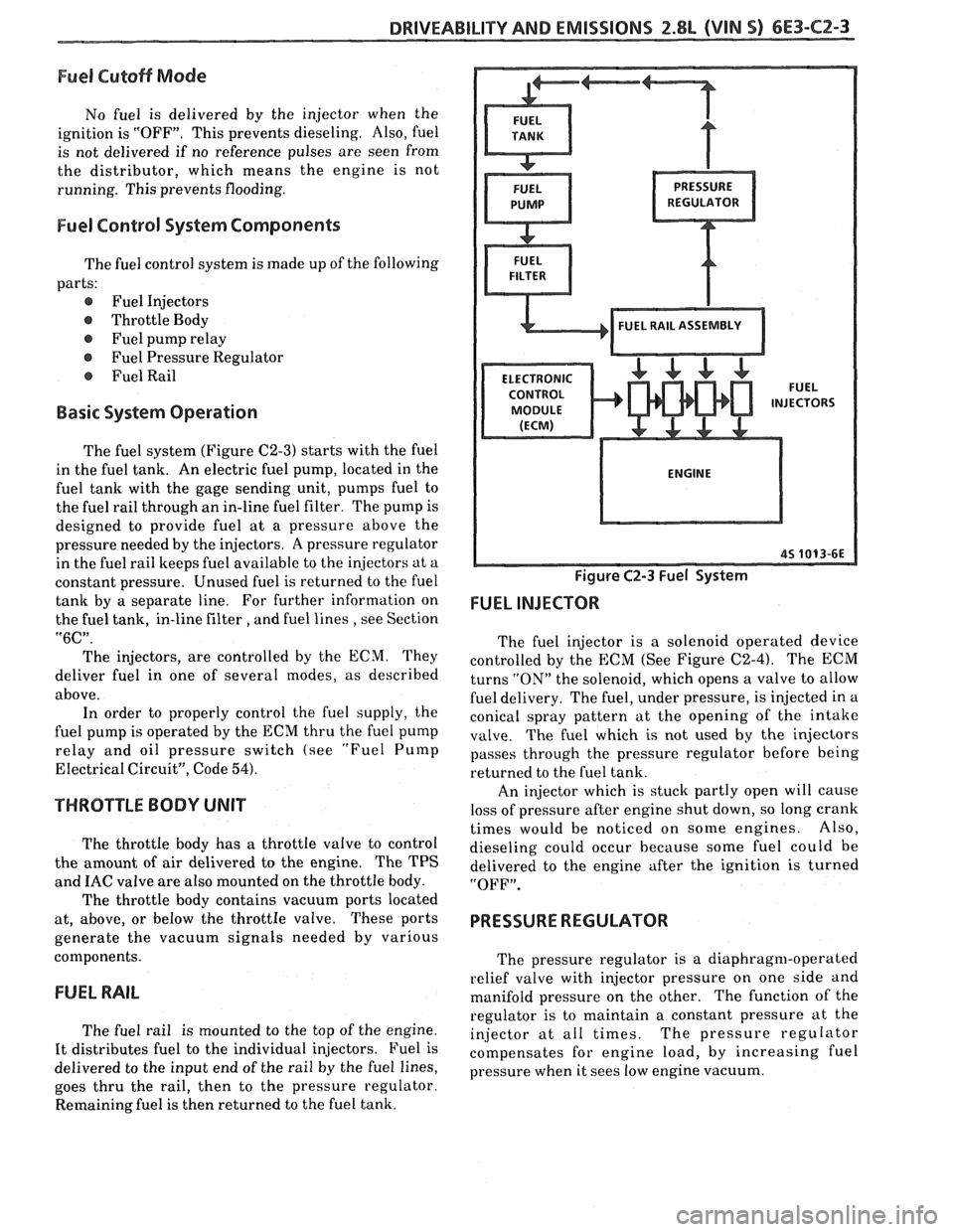
DRIVEABILITY AND EMISSIONS 2.8L (VIN 5) 6E3-CZ-3
Fuel Cutofl Mode
No fuel is delivered by the injector when the
ignition is "OFF". This prevents dieseling. Also, fuel
is not delivered if no reference pulses are seen from
the distributor, which means the engine is not
running. This prevents flooding.
Fares Control System Components
The fuel control system is made up of the following
parts:
e Fuel Injectors
@ Throttle Body
e Fuel pump relay
@ Fuel Pressure Regulator
@ Fuel Rail
Basic System Operation
The fuel system (Figure C2-3) starts with the fuel
in the fuel tank. An electric fuel pump, located in the
fuel tank with the gage sending unit, pumps fuel to
the fuel rail through an in-line fuel filter. The pump is
designed to provide fuel at a pressure above the
pressure needed by the injectors. A pressure regulator
in the fuel rail keeps fuel available to the injectors at a
constant pressure. Unused fuel is returned to the fuel
tank by a separate line. For further information on
the fuel tank, in-line filter
, and fuel lines , see Section
"6C".
The injectors, are controlled by the ECM. They
deliver fuel in one of several modes, as described
above. In order to properly control the fuel supply, the
fuel pump is operated by the ECM thru the fuel pump
relay and oil pressure switch (see
"Fuel Pump
Electrical Circuit", Code 54).
THROTTLE BODY UNIT
The throttle body has a throttle valve to control
the amount of air delivered to the engine. The TPS
and
IAC valve are also mounted on the throttle body.
The throttle body contains vacuum ports located
at, above, or below the
throttIe valve. These ports
generate the vacuum signals needed by various
components.
FUEL RAIL
The fuel rail is mounted to the top of the engine.
It distributes fuel to the individual injectors. Fuel is
delivered to the input end of the rail by the fuel lines,
goes thru the rail, then to the pressure regulator.
Remaining fuel is then returned to the fuel tank.
Figure C2-3 Fuel System
FUEL INJECTOR
The fuel injector is a solenoid operated device
controlled by the ECM (See Figure C2-4). The ECM
turns
"ON" the solenoid, which opens a valve to allow
fuel delivery. The fuel, under pressure, is injected in a
conical spray pattern at the opening of the intake
valve. The fuel which is not used by the injectors
passes through the pressure regulator before being
returned to the fuel tank.
An injector which is stuck partly open will cause
loss of pressure after engine shut down, so long crank
times would be noticed on some engines. Also,
dieseling could occur because some fuel could be
delivered to the engine after the ignition is turned
"OFF".
PRESSURE REGULATOR
The pressure regulator is a diaphragm-operated
relief valve with injector pressure on one side and
manifold pressure on the other. The function of the
regulator is to maintain a constant pressure at the
injector at all times. The pressure regulator
compensates for engine load, by increasing fuel
pressure when it sees low engine vacuum.
Page 739 of 1825
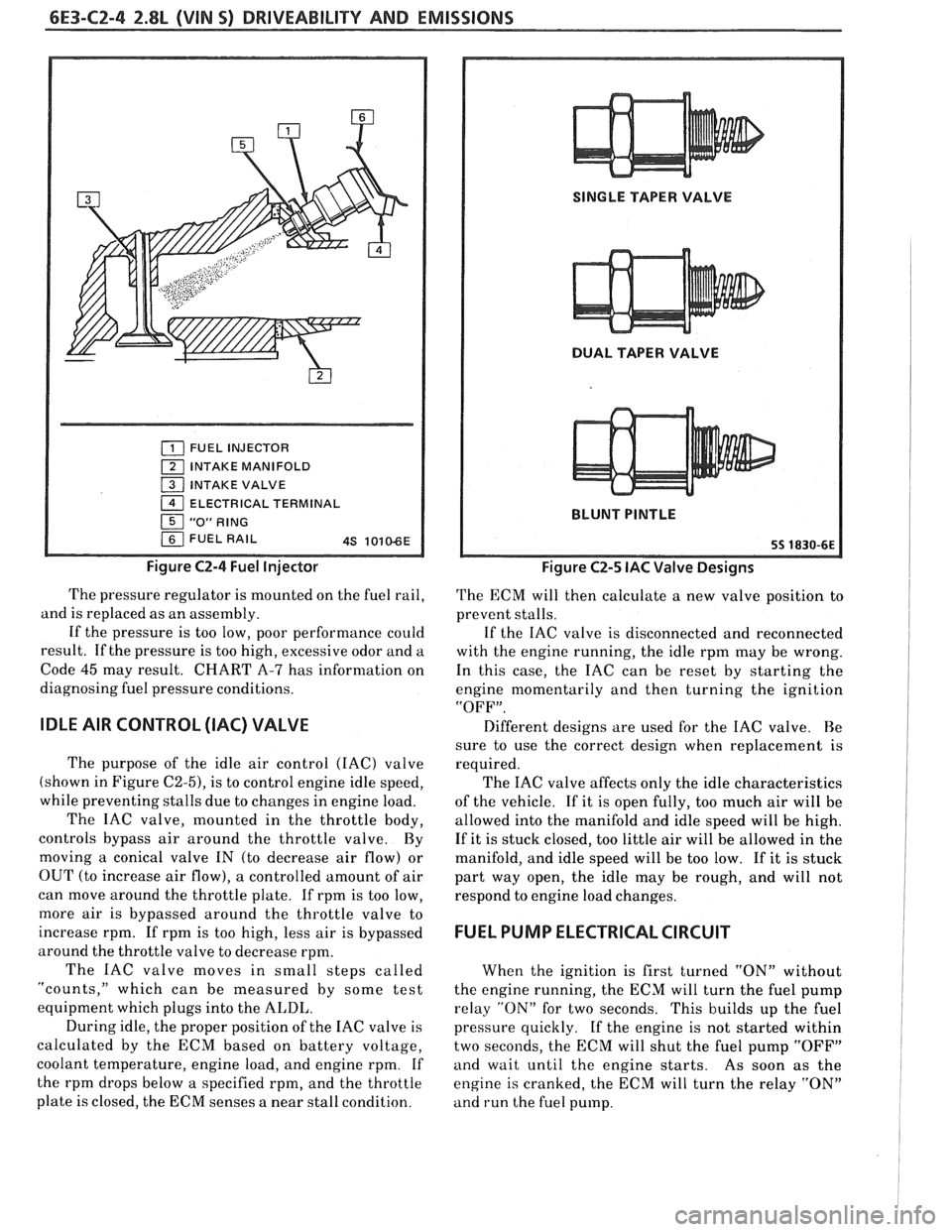
6E3-CZ-4 Z.8L (WIN 5) DRIVEABILITY AND EMISSIONS
FUEL INJECTOR
1 INTAKE MANIFOLD
1 INTAKE VALVE
1 ELECTRICAL TERMINAL
151 "0" RING
1 FUEL RAIL 4.5 101ME
Figure C2-4 Fuel Injector
The pressure regulator is mounted on the fuel rail,
and is replaced as an assembly.
If the pressure is too low, poor performance could
result. If the pressure is too high, excessive odor and a
Code
45 may result. CHART A-7 has information on
diagnosing fuel pressure conditions.
IDLE AIR CONTROL (IAC) VALVE
The purpose of the idle air control (IAC) valve
(shown in Figure C2-5), is to control engine idle speed,
while preventing stalls due to changes in engine load.
The IAC valve, mounted in the throttle body,
controls bypass air around the throttle valve. By
moving a conical valve IN
(to decrease air flow) or
OUT (to increase air flow), a controlled amount of air
can move around the throttle plate. If rprn is too low,
more air is bypassed around the throttle valve to
increase rpm. If rprn is too high, less air is bypassed
around the throttle valve to decrease rpm.
The IAC valve moves in small steps called
"counts," which can be measured by some test
equipment which plugs into the ALDL.
During idle, the proper position of the IAC valve is
calculated by the ECM based on battery voltage,
coolant temperature, engine load, and engine rpm.
If
the rprn drops below a specified rpm, and the throttle
plate is closed, the ECM senses a near stall condition.
SINGLE TAPER VALVE
DUAL TAPER VALVE
BLUNT
PINTLE
Figure C2-5 IAC Valve Designs
The ECM will then calculate a new valve position to
prevent stalls.
If the IAC valve is disconnected and reconnected
with the engine running, the idle rprn may be wrong.
In this case, the IAC can be reset by starting the
engine momentarily and then turning the ignition
"OFF".
Different designs are used for the IAC valve. Re
sure to use the correct design when replacement is
required.
The IAC valve affects only the idle characteristics
of the vehicle. If it is open fully, too much air will be
allowed into the manifold and idle speed will be high.
If it is stuck closed, too little air will be allowed in the
manifold, and idle speed will be too low. If it is stuck
part way open, the idle may be rough, and will not
respond to engine load changes.
FUEL PUMP ELECTRICAL CIRCUIT
When the ignition is first turned "ON" without
the engine running, the ECM will turn the fuel pump
relay
"ON" for two seconds. This builds up the fuel
pressure quickly. If the engine is not started within
two seconds, the ECM will shut the fuel pump
"OFF"
and wait until the engine starts. As soon as the
engine is cranked, the ECM will turn the relay
"ON"
and run the fuel pump.
Page 740 of 1825
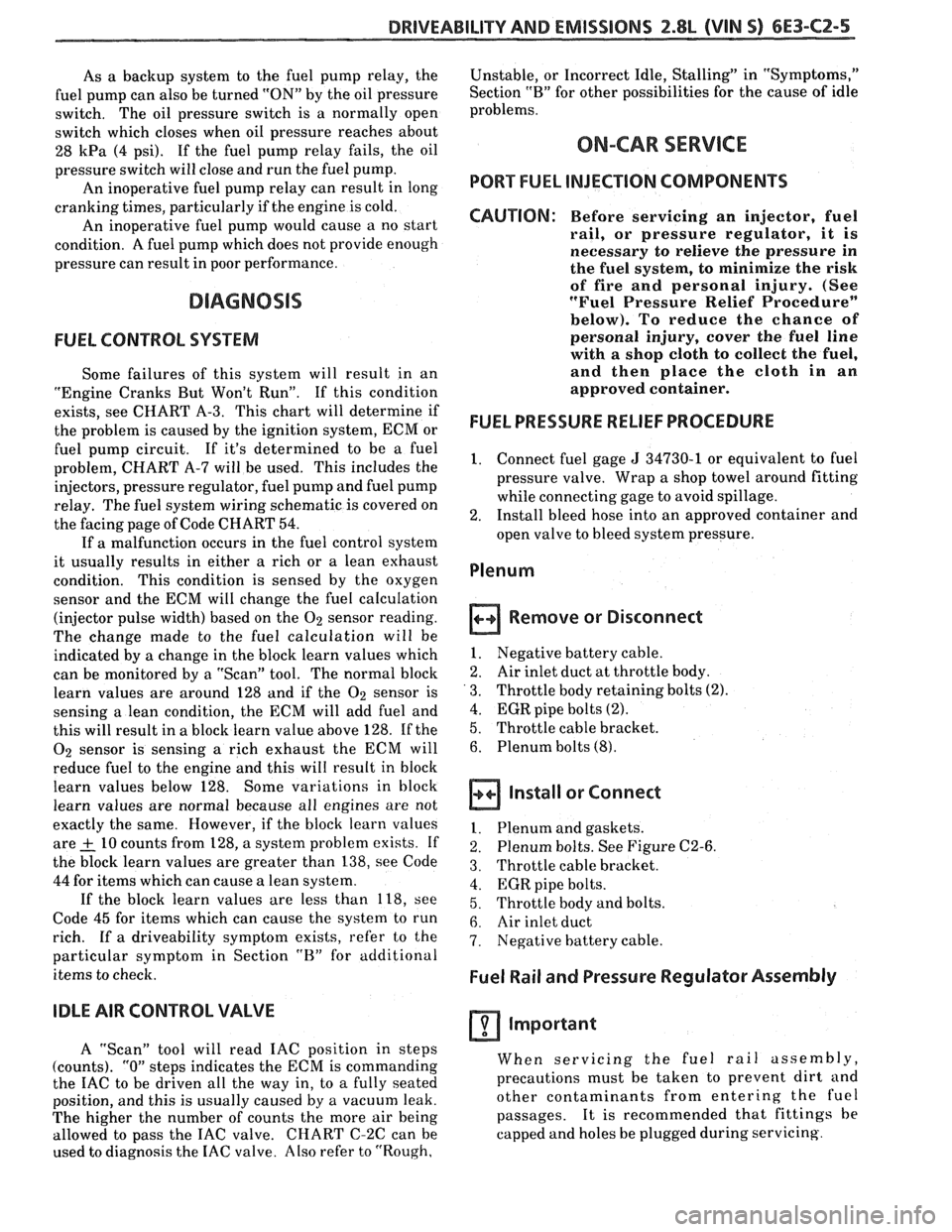
DRIVEABILITY AND EMISSIONS 2.8L (VIN 5) 6E3-C2-5
As a backup system to the fuel pump relay, the
fuel pump can also be turned "ON" by the oil pressure
switch. The oil pressure switch is a normally open
switch which closes when oil pressure reaches about
28
kPa (4 psi). If the fuel pump relay fails, the oil
pressure switch will close and run the fuel pump.
An inoperative fuel pump relay can result in long
cranking times, particularly if the engine is cold.
An inoperative fuel pump would cause a no start
condition. A fuel pump which does not provide enough
pressure can result in poor performance.
FUEL CONTROL SYSTEM
Some failures of this system will result in an
"Engine Cranks But Won't Run". If
this condition
exists, see CHART A-3. This chart will determine if
the problem is caused by the ignition system, ECM or
fuel pump circuit. If
it's determined to be a fuel
problem, CHART
A-7 will be used. This includes the
injectors, pressure regulator, fuel pump and fuel pump
relay. The fuel system wiring schematic is covered on
the facing page of Code CHART
54.
If a malfunction occurs in the fuel control system
it usually results in either a rich or a lean exhaust
condition. This condition is sensed by the oxygen
sensor and the ECM will change the fuel calculation
(injector pulse width) based on the
02 sensor reading.
The change made to the fuel calculation will be
indicated by a change in the block learn values which
can be monitored by a "Scan" tool. The normal block
learn values are around 128 and if the
O2 sensor is
sensing a lean condition, the ECM will add fuel and
this will result in a block learn value above 128. If the
02 sensor is sensing a rich exhaust the ECM will
reduce fuel to the engine and this will result in block
learn values below 128. Some variations in block
learn values are normal because all engines are not
exactly the same. However, if the block learn values
are
+ 10 counts from 128, a system problem exists. If
the block learn values are greater than 138, see Code
44 for items which can cause a lean system.
If the block learn values are less than 118, see
Code
45 for items which can cause the system to run
rich. If a driveability symptom exists, refer to the
particular symptom in Section
"B" for additional
items to check.
IDLE AIR CONTROL VALVE
A "Scan" tool will read IAC position in steps
(counts).
"0" steps indicates the ECM is commanding
the IAC to be driven all the way in, to a fully seated
position, and this is usually caused by a vacuum leak.
The higher the number of counts the more air being
allowed to pass the IAC valve. CHART C-2C can be
used to diagnosis the IAC valve. Also refer to "Rough, Unstable,
or Incorrect Idle, Stalling" in "Symptoms,"
Section
"B" for other possibilities for the cause of idle
problems.
ON-CAR SERVICE
PORT FUEL INJECTION COMPONENTS
CAUTION:
Before servicing an injector, fuel
rail, or pressure regulator, it is
necessary to relieve the pressure in
the fuel system, to minimize the risk
of fire and personal injury. (See
"Fuel Pressure Relief Procedure"
below). To reduce the chance of
personal injury, cover the fuel line
with a shop cloth to collect the fuel,
and then place the cloth in an
approved container.
FUEL PRESSURE RELIEF PROCEDURE
Connect fuel gage J 34730-1 or equivalent to fuel
pressure valve. Wrap a shop towel around fitting
while connecting gage to avoid spillage.
Install bleed hose into an approved container and
open valve to bleed system pressure.
Plenum
Remove or Disconnect
1. Negative battery cable.
2. Air
inlet duct at throttle body.
3. Throttle body retaining bolts
(2).
4. EGR pipe bolts (2).
5. Throttle cable bracket.
6. Plenum bolts (8).
Install or Connect
I. Plenum and gaskets.
2. Plenum bolts. See Figure C2-6.
3. Throttle cable bracket.
4. EGR pipe bolts.
5. Throttle body and bolts.
6. Air inlet duct
7. Negative battery cable.
Fuel Rail and Pressure Regulator Assembly
Important
When servicing the fuel rail assembly,
precautions must be taken to prevent dirt and
other contaminants from entering the fuel
passages. It is recommended that fittings
he
capped and holes be plugged during servicing.
Page 741 of 1825
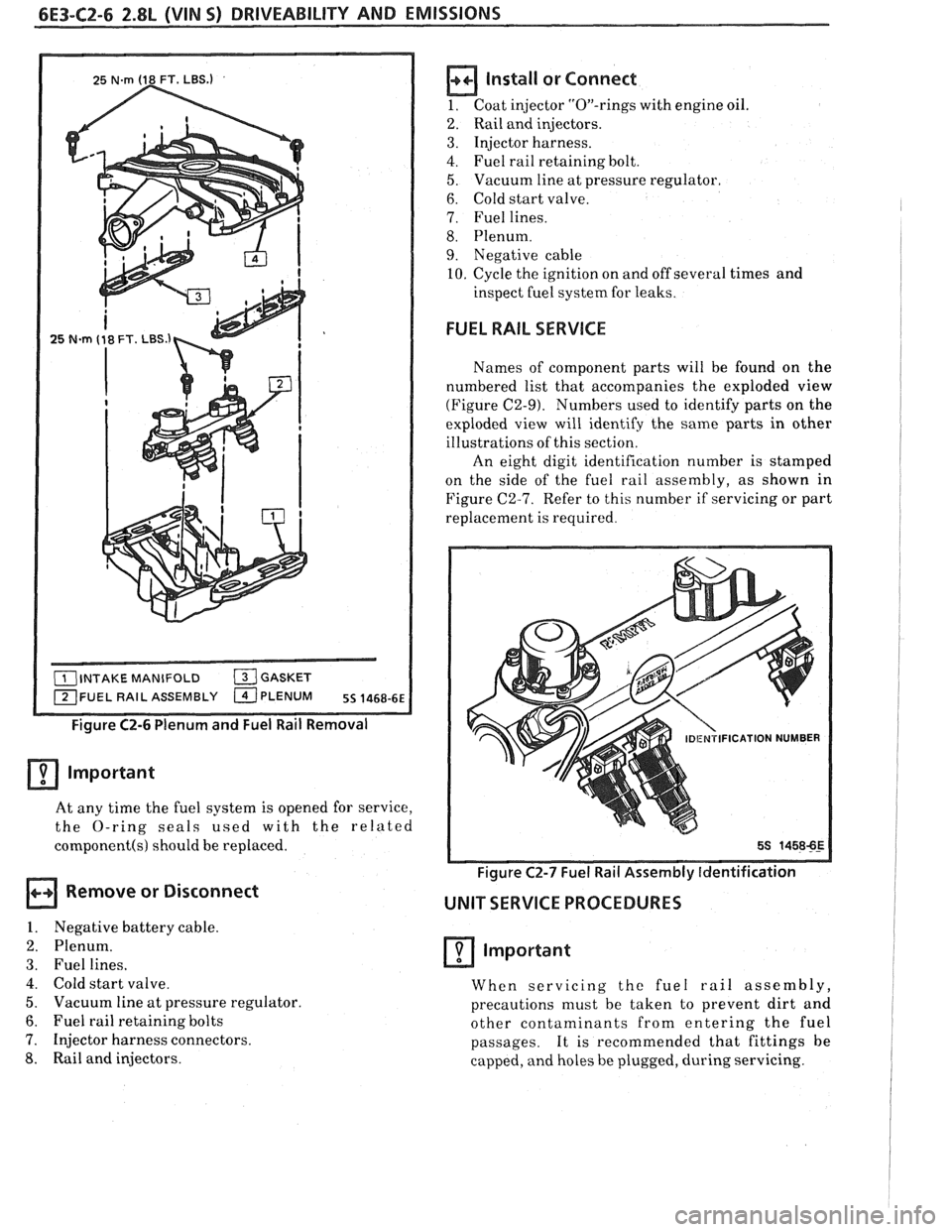
6E3-C2-6 2.8L (VIN 5) DRIVEABILITY AND EMISSIONS
FUEL RAIL ASSEMBLY
Figure C2-6 Plenum and Fuel Rail Removal
Important
At any time the fuel system is opened for service,
the O-ring seals used with the related
component(s) should be replaced.
Remove or Disconnect
1. Negative battery cable.
2. Plenum.
3. Fuel lines.
4. Cold start valve.
5. Vacuum line at pressure regulator.
6. Fuel rail retaining bolts
7. Injector harness connectors.
8. Rail and injectors.
install or Connect
1. Coat injector "On-rings with engine oil.
2. Rail and injectors.
3. Injector harness.
4. Fuel rail retaining bolt.
5. Vacuum line at pressure regulator.
6. Cold start valve.
7. Fuel lines.
8. Plenum.
9. Negative cable
10. Cycle the ignition on and off several times and
inspect fuel system for leaks.
FUEL RAIL SERVICE
Names of component parts will be found on the
numbered list that accompanies the exploded view
(Figure C2-9). Numbers used to identify parts on the
exploded view will identify the same parts in other
illustrations of this section.
An eight digit identification number is stamped
on the side of the fuel rail assembly, as shown in
Figure C2-7. Refer to this number if servicing or part
replacement is required.
Figure C2-7 Fuel Rail Assembly [dentification
UNIT SERVICE PROCEDURES
Important
When servicing the fuel rail assembly,
precautions must be taken to prevent dirt and
other contaminants from entering the fuel
passages. It is recommended that fittings be
capped, and holes be plugged, during servicing.